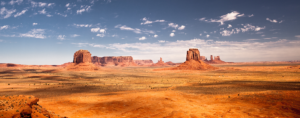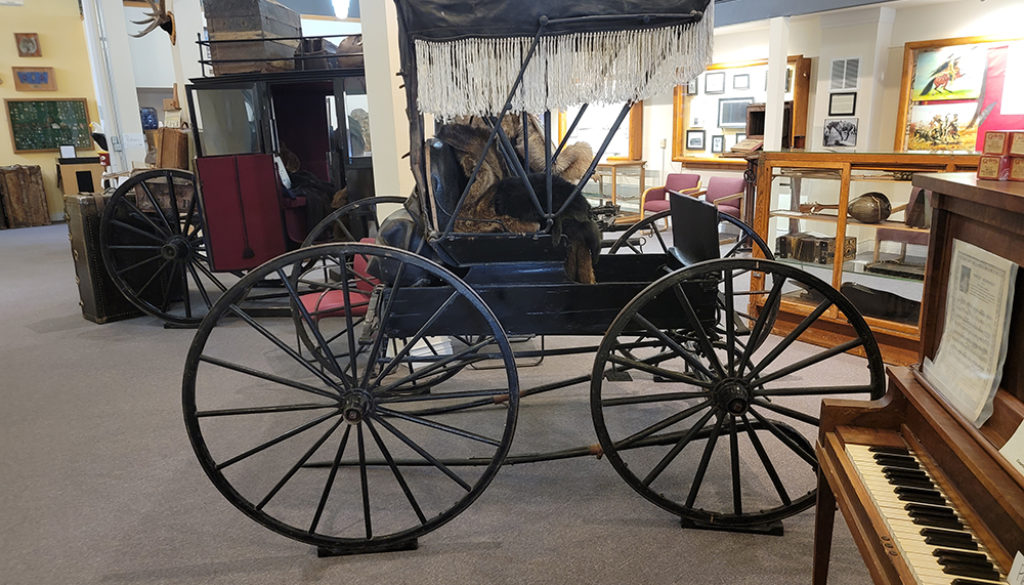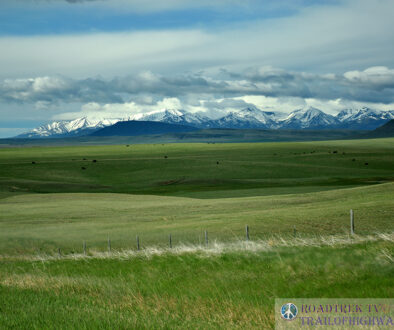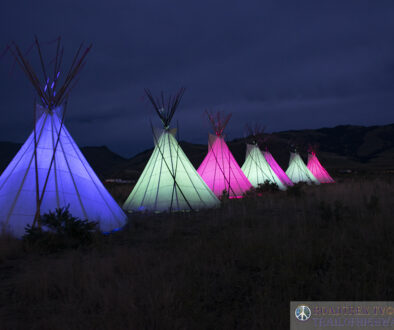Upper Musselshell Museum Tour
Beginning of a Three Hour Tour of the Upper Musselshell Museum
We start off with this cabin it is original from this area. It was donated by Dan and Sandra Debuff. This is typical of the homesteading cabins that were built around here in the 1910s through 1920s. Now this one is special because it’s tongue and groove lumber. Back in the day, before the railroad was able to supply everything, there were sawmills up along these mountains, but they all had tie contracts. They were cutting ties to make railroads. They weren’t cutting lumber. So you had a choice of either waiting until they brought in a load of lumber to the local lumberyard, or what a lot of them did was they would hire an emigrant car back East. And an emigrant car was a boxcar that you could rent and it was $45 from Chicago to Harlowton, Montana.
Now, a lot of the big ranchers like Tudor Wilson, for example, would have their hired men file a claim for a section of ground and then prove up on it and they would pay the guy while he was on that ground or proving up on it, and then he would buy the… Or they would sign over when it was proved up. That’s how a lot of these ranches got a lot of land. And it was all perfectly legal, because once it was proved up, the guys can do with what he wanted.
And they actually made more on it probably working for the ranch than they would have working the ground. But one of the criteria for making a claim to prove up on was you had to have an 8 x 10 cabin. It was in the description, it was in the instructions. The problem was, there was no measurement added. So, people would make an 8 x 10 inch doll house to set on these extra claims. The instruction said 8 x 10. It was 8 x 10.
But prior to… But after… Even after they had modified the Homestead Act, by 1880, there had only been about 370 claims filed in eastern Montana in part due to the Indian troubles. Once those wars were pretty much handled after the 1878 Nez Perce Wars, people started moving in more and more in the Milwaukee road and other railroads because they had been given land grants to pay for bringing the settlers… Or for bringing the rails out here advertised heavily to bring settlers out here.
Well, those are nice-looking ads.
Yes. They were very expensive ads. But you’ll see that you got Harlow Town right there on the line and round up Musselshell, they’re all on the Milwaukee line. Now, this cabin is a little different in the fact that music was very important to the settlers. They didn’t have Victrola’s, they didn’t have bands, they didn’t have radios. You wanted music, you made it yourself. And when the men came out, they usually carried something small, a harmonica, a banjo, a fiddle, something like that, but when the women came, they had to be civilized. This is an original 1885 organ, pump organ that would have been brought out in those times. Now, it’s a little big for this cabin, but it was such a valued piece to the family, it would have been given room in a cabin even of this size, because it would have been so important to their morale and welfare, especially during long winters.
Yeah, the way the wind blows out here.
Yup. Now, if you look… Now, we’ve got other artifacts like these clothes… That’s on a washing machine.
You’ll notice on the plunger, it has baffles in it.
Oh, wow.
Yeah. This was actually patented back in about 1833, but what you did was by working it as the agitator, it would move the water around and clean your clothes. It was better than smacking your clothes on a rock, on the side of the creek. And then the Voyager snowshoes, you had to have those in deep country snow. Those are the ones you use for traveling for a long ways. A lot of people think of the bear paws or that, those are for close quarter, real tight in brushy areas. They don’t work when you’re trying to travel long distances.
Right.
These kind were used by the mail service to take mail back into mining camps like Independence…
Okay.
That there was no way to get in otherwise. So they’d put a backpack full of mail on, strap those snowshoes, or they’d pull a toboggan loaded with mail. And up and over the mountains they would go.
That sounds like too much work.
It was. It was.
I’d rather carry a backpack.
And Ricky the Rattler.
Yeah.
Now, this is the kind… If you didn’t have a log cabin or a frame cabin, this is the kinda building you would have probably made. This is called the Soddy. And you’ll notice the walls are about 3 feet thick.
Right.
Now, when I first saw this, I was going, “Man, how them gals keep their blouses so white?” Because in a soddy, you had a sod roof as well.
Right.
And usually you had to hang canvas or something on the inside to keep dirt, and bugs, and rattles snakes from dropping in on your head. But you’ll notice in this picture, this grass, this is just constructed, this is moving day, they’re going into it. That’s why they took the picture.
That’s why their clothes are so clean, huh? Okay.
Yeah. But they were a lot warmer than frame built or board built house like this. Now, this house would have probably been covered in tar paper or felt to seal it and to keep the drafts and everything out. That’s what… The original tar paper shack.
Yup, they’re all over the south or they still were in the ’80s.
Oh yeah. Oh yeah. Now these… This bar from the Black Bear pool hall in Harlow.
Okay.
The slot machine, it was in there until the 1970s, I believe. But we have several… We have this set up as a demonstration of what a lot of bars were. In the mining camps, a bar could be a tent with two barrels like that rain barrel and the board across for the bar. They weren’t too picky, as long as you had bar water, but with the coming of civilization, they made bars. Now you’ll see the big mahogany back bars in some of the old buildings, those were very expensive and had to be shipped in and those were only for the high class places. This was a barber shop, pool hall, and bar. So, it was a working man…
This was a working man’s bar.
Yeah.
Now, our front piece here, these cabinets all came from the Barber store.
Oh, really?
The barber no longer basically exists, there’s a couple buildings out there, but… You’ll see pictures along in the front thereof…
Okay. Yeah, I’d gone to Barber and looked around and there was nothing there except for some old dilapidated buildings.
Yeah. And that big concrete thing sitting out in the middle field.
Yup, exactly. What was that?
Do you know what that is?
No, I have no idea.
For a long time, I thought it was a jail cell, it’s not. That was the bank vault.
Oh, that makes sense.
Yeah. [chuckle] But he didn’t seem to have several items that would have been carried in the store, as well as displays like the embroidery and Notions, needles. Now, this is kind of a nice one. This talks about… Or this is from the Graves Motel. It was a drummer. A traveling salesman, who went through and didn’t pay his bill and left his samples case. So, this was stuff that was in his case. Now, my favorite piece. You know what a straight razor is?
Oh yes, totally.
Okay. How about the safety razors?
No, I don’t think I’ve ever seen one.
This is a safety razor.
Oh, okay. So that’s what they used to call those. Okay.
Yeah, they didn’t cut you as bad as the…
The straight razors.
Straight razors.
Yeah.
Save your jugular.
Yeah. People were very, very thrifty, because this stuff was expensive. So you put your razor blade in here…
Oh, wow. Sharpener.
And you could strop your blade and use it over and over, instead of the disposable razors, you use this.
That’s cool.
And then we have some pictures up here of the Merchel building, which is the building we’re in right now. It was the first building built in stone on this street, Central Avenue…
Oh, wow.
After the big fire of 1906 that destroyed Harlow Town. Harlow Town Main Street used to run from the court house past the Catholic Church, what’s now the Catholic Church, and that was Main Street.
Oh, okay.
But after… It burned, there were about 24 buildings burned. They started building on Central Avenue because it went down to the rail depot. This was the first building built on this street.
Oh, that’s cool.
It’s older than the graves.
Wow.
And in fact, during the fire… See because of the Chinese Exclusion Act in the 1850s, when they were building the railroads up here, they couldn’t import Chinese workers. But they didn’t say anything about Japanese. So, at the time of the fire, there were about 200 Japanese that were working for the Northern Pacific or Milwaukee Roads. And when the fire was going, they saved… The Japanese made a bucket line, pulling merchandise out of the store and saved about $25,000 worth of merchandise from one of the local stores that was uptown.
Wow.
Yeah.
That’s impressive.
Well, now what’s really impressive is, there were about 30 Japanese families that stayed in Harlow Town after the fire and after the railroads were built. In fact, if you look at this blueprint that was drawn for the Milwaukee Road, you’ll see that’s Japan Town.
Oh, okay.
They even note their outhouses and stuff.
Wow.
And they stayed. And in 1942 after Pearl Harbor, when the rest of the Japanese were put into internment camps, just right after December 7th, the sheriff went down and took their cameras and rifles. But when the feds came and said we wanna put these guys into these camps, the city fathers of Harlow Town said, “No, these are our friends and neighbors. They stay.”
That’s impressive.
So, the Harlow Town Japanese did not go. They didn’t lose their…
But anyway, there were several people from Harlow that served in the 442 Combat Brigade, the Go for Broke Battalion of Japanese Nisei, first generation Japanese that served in Europe. Daniel Emhoff of… Or Inouye, sorry, Inouye of Hawaii, Medal of Honor winner, lost his right arm in the war, he was one of the Go for Broke Battalion. It was comprised entirely of Japanese-Americans, but they wouldn’t let them fight in the Pacific. They sent them over to Europe. So they mostly fought in Italy and France, but out of the 18,000 men that served in it, there were about 9,000 Purple Hearts and other citations given, because they were trying to prove themselves as Americans and they just really went. And Hank Muneta was one of them from here. In fact, later on he served as Postmaster for Harlow, and he was also with the bank here for about 20 years. And he just passed away in the early ’80s, but he was one of the last Japanese from Harlow Town. And our player piano of course, gotta have one of those if you’ve gonna have a bar.
Totally, that’s totally western.
These actually didn’t come out until… I believe the earliest model I’ve seen was about 1888, 1890.
Okay.
They were very expensive. This was not the kind of thing that your local watering hole would have.
Right.
If you were talking about maybe the Golden Cage in Deadwood or something like that, very upscale, then they’d have a player piano. Otherwise, you had the professor banging away, who was a guy who was usually paid in drinks and his tunes could get a little…
As the night went on.
At least it was music.
Yep, that’s right.
We are also part of the Nez Perce Trail.
Yeah, which I find very interesting.
In 1877, the Nez Perce were supposed to be moved to a Reservation in the Wallowa Valley in Idaho in Washington, out there tribal lands. And Joseph, their primary Chief was willing to go, but White Bird, one of the Sub-Chiefs wasn’t and got mad and went out and…
Plan a Montana Adventure
Whether you are looking for a day on a Montana River with a guide or lost in a wilderness area, we have you covered at Get Lost in America.




